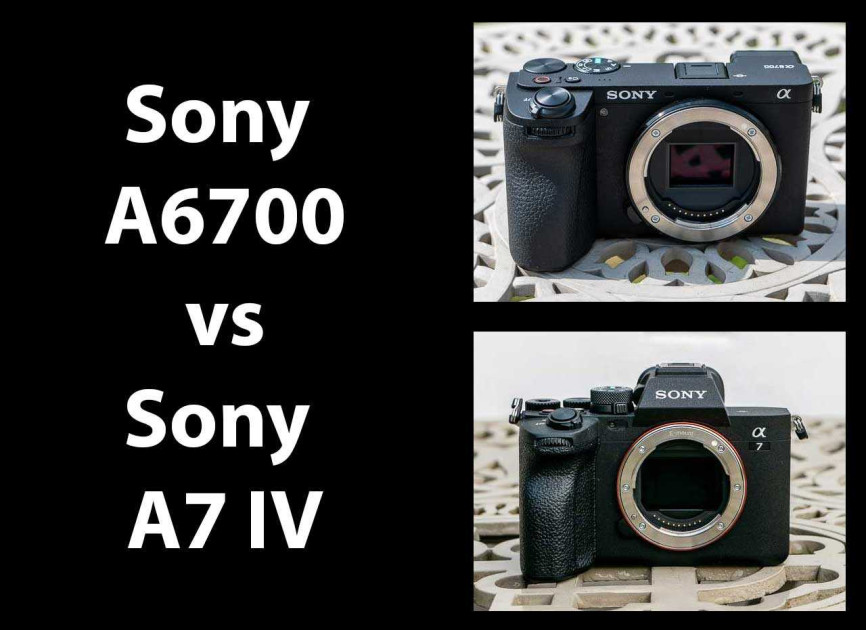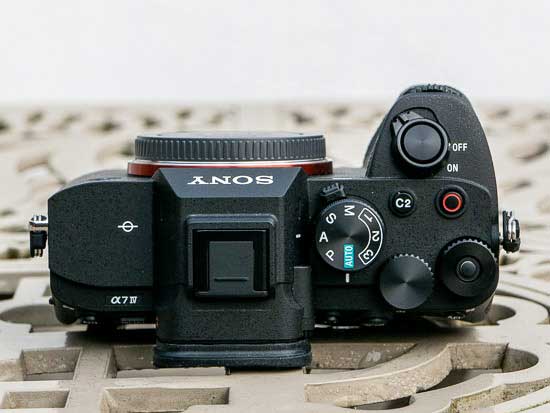
The A6700 is the flagship APS-C model in the extensive Sony range, whilst the popular A7 IV sits in the middle of the full-frame options. Despite having different sensor sizes and a different external design approach, they’re actually very similar when it comes to their core specifications.
So we’re bringing you this in-depth Sony A6700 vs Sony A7 IV head-to-head comparison to help you choose between the two.
You can also read our detailed Sony A7 IV review and Sony A6700 review to find out exactly what we think of each one.
Sensor

The image sensor is the biggest difference between the A6700 and the A7 IV, and is the main reason why you should choose one over the other.
The A7 IV has a 35mm full-frame sensor and the A6700 has an APS-C sensor.
The former sensor is physically larger than the latter by 2.3x, which means that the image quality from the A7 IV should theoretically be better. Having said that, the number of megapixels on the A7 IV is significantly higher – 33mp versus 26.1mp – which may make things more equal.
Both cameras have a BSI (backside illuminated) sensor, though, which is better at collecting light than a normal CMOS sensor, so the difference in image quality will come down to the physically larger pixels of the A7 IV.
ISO Speed
There’s almost nothing to choose between the two models here, with both the A6700 and A7 IV offering ISO ranges that run all the way up ISO 204,800.
There is a slight difference between the two models here in favour of the A7 IV, with the older camera offering a native ISO range of 100-51,200 and the newer A6700 running from 100-32,000.
The ISO speed on both cameras can be expanded to ISO 204,800 and both can drop down to ISO 50 if required.
Video

The cheaper A6700 actually offers slightly more advanced video recording specs and performance than the older A7 IV.
The A7IV offers 4K UHD video recording in the XAVC S-I format, up to 60fps at 4:2:2 color depth in 10-bit to the inserted memory card or over HDMI to compatible third party recorders with either Long GOP or All-Intra frame encoding.
4K/30p video is oversampled from 7K in full-frame, but unfortunately 4K/60p is oversampled from 4.8K in the APS-C Super 35 mode.
So when shooting in 4K at 30p, the camera utilises the full width of the image sensor to oversample from 7K’s worth of data, but at 60p, a 1.5x crop is applied.
It supports the S-Cinetone, HLG, S-Log3 and S-Log2 profiles.
The A6700 can capture oversampled 4K from 6K at up to 60p and also 4K/120p with a 1.62x crop. Video can be captured in 10-bit 4:2:2 or 4:2:0 in either H.265 or H.264 AVC files.
The Slow and Quick motion mode offers frame rates ranging from 1fps to 240fps at 1080p quality.
Only the newer A6700 offers the clever Auto Framing feature which uses the camera’s AI-based subject recognition technology to automatically crop the frame to keep the subject in a prominent position when shooting movies, even when the camera is mounted on a tripod.
The A7 IV does have a range of video settings that you won’t find on the A6700, including Breathing Compensation to help reduce focus breathing with certain Sony lenses, Shockless White Balance to make manual changes in white balance more smooth, Flexible Exposure Mode to switch between auto and manual exposure settings separately for the aperture and shutter speed, and two types of Shot Marks to mark favourite takes or scenes.
Both models support the newer Digital Audio Interface (via the Multi Interface Shoe) to enable use of the ECM-B1M digital shotgun microphone.
Autofocus

The new A6700 has the same hybrid autofocus system with phase detection and and contrast detections points as the A7 IV, but with more phase-detection points and, most importantly, greatly expanded subject recognition.
On the A6700 there are 759 phase-detection points and 25 contrast points that cover 93% of the frame, with the system working down to -3EV low-light.
On the A7 IV there are 759 on-sensor phase-detect points, supported by 425 contrast detect points that cover 94% of the frame and work all the way down to -4EV.
By far the biggest difference between the two models in terms of their auto-focusing performance is subject recognition.
Sony has added an AI deep learning processing unit to the newer camera which enables it to recognise far more subjects than the previous model, and also greatly improves the detection of humans and animals/birds.
The A7 IV’s auto-focus system supports Real-time Tracking AF and also Human, Animal and Bird Eye AF, all for both stills and movies, making it the first Sony camera to offer such comprehensive AF support for both shooting modes when it was launched.
For the first time on an Sony APS-C sensor camera. the A6700 can recognise a human via its pose as well as its eye and face. So if the person’s head is turned away from the camera, the A6700 will still accurately detect the subject as human based on its AI deep learning.
Animal and bird detection has been expanded from just being able to recognise the eye on the A7 IV to the eye, head and body on the A6700.
As well as humans and animals, the A6700 also has the ability to recognise airplanes, cars, trains and insects. The A7 IV cannot recognise any of these subjects.
Burst Shooting

The two models are perhaps surprisingly evenly matched when it comes to the headline continuous shooting speeds.
The A7 IV offers 10fps burst shooting with Full AF/AE tracking, although only if you shoot JPEGs and/or compressed Raws, while the A6700 can shoot at a slightly faster 11fps.
The burst speed on the A7 IV does drop quite dramatically, though, to just 5-6fps if you want to shoot either uncompressed or lossless compressed Raw files, which we suspect a lot of users would prefer.
There is one significant difference between them though that has more of an impact on burst shooting performance – the buffer size.
The A7 IV is able to shoot at 10fps for up to 830 JPG+RAW (uncompressed) or 1,000 JPGs, lossless compressed or compressed RAW in one high-speed burst.
The A6700 has a similar sized buffer to the A7 IV, at least when it comes to JPEGs, being able to shoot at 11fps for over 1,000 Fine JPEGs. It actually has a smaller buffer for RAW files, though, only taking 59 RAW images or 44 RAW and JPEGs in one high-speed burst.
There is a pretty big caveat for the A7 IV to be aware of – it can only be achieved when using a Cfexpress Type A card, which are much more expensive than SD cards, with the fastest rate dropping to 8fps if you use the latter.
Body

These two cameras take a completely different approach to their external design, with the A6700 following the long-established rangefinder-esque format of the A6000-series cameras and the A7 IV inheriting the mini-DSLR feel of the A7-series.
There are some clear design similarities though that have been passed down the line-up, with the external controls broadly mimicking each other.
Firstly, the handgrip on the A6700 has been made larger and more prominent to offer greater balance with heavy or telephoto lenses. It’s not as big as the one on the A7 IV but is welcome improvement none-the-less.
Both cameras have a second command dial at at the top of the handgrip which makes it even easier to change the key exposure settings in conjunction with the rear command dial.
On the rear, the Still/Movie/S&Q dial from the A7 full-frame series has made its way onto the A6700, joined by a larger, more prominent AF On button and a new C1 custom button which accesses the white balance settings by default.
On the rear, the Still/Movie/S&Q dial from the A7 full-frame series has made its way onto the A6700, joined by a larger, more prominent AF On button and a new C1 custom button which accesses the white balance settings by default.
The A6700 doesn’t have either an exposure compensation dial, AEL button or joystick though, all of which can be found on the larger A7 IV.
Viewfinder

The A7 IV has a higher-resolution, 3.69m-dot EVF that features 100% scene coverage, 0.78x magnification and a 120fps high frame rate option to help track moving subjects more smoothly with virtually no lag.
The A6700 has a 2.36m-dot XGA OLED electronic viewfinder which offers 100% scene coverage, 0.70x magnification and a 120fps high frame rate setting.
LCD Screen

Both cameras have the same 3-inch, 3:2 ratio LCD screen with 1.03 million pixels – we’d have expected to see a much higher resolution screen on a new camera released in 2023.
Both models have a fully articulating vari-angle design which means that you can flip out the screen to the side, rotate it forwards for easier operation when pointing the camera at yourself, and fold it flat against the back of the camera to stop it from getting scratched.
IBIS
Both cameras have 5-axis optical in-body image stabilisation that corrects for pitch and yaw shake.
The A7 IV has built-in image stabilisation worth up to 5.5 shutter speed stop and the A6700 offers up to 5 stops.
The A7 IV additionally has a feature called Active Mode that increases the stabilization for movie shooting.
You can also stabilise the A7IV’s footage in post-production using data from the camera’s gyro sensor and the Sony Catalyst software.
Sony claim that the A6700 has an updated algorithm that provides more precise control and detection down to the single pixel level, but we’re not sure at this point what material effect that has on the resulting images.
Memory Cards

Perhaps unsurprisingly given its compact size, the A6700 only has a single memory card slot.
It does support the faster SD UHS-II memory card standard and is located in a dedicated memory card port that’s hidden behind a lockable door on the left-hand side of the camera.
The A7 IV has dual card slots, and one of these slots can interchangeably use UHS-II SD-cards and even faster CFexpress Type A cards.
Battery Life

The Sony A6700 uses exactly the same large capacity NP-FZ100 battery as the A7 IV model which offers a CIPA-rated battery life of around 700 shots when using the LCD screen and 750 when using the viewfinder.
Both cameras can also be powered and charged via a USB connection, which is useful if you’re out and about and have a compatible powerbank to plug the camera into, and both use the newer USB-C variant.
Price

A price-tag of £1450 / €1700 body only, £1550 / €1800 with the Sony E PZ 16-50mm F3.5-5.6 OSS kit lens or £1800 / €2100 with the E 18-135mm F3.5-5.6 OSS zoom lens makes the new Sony A6700 much, much cheaper than the A7 IV.
In comparison, the A7 IV is priced at £2399 / €2799 / $2499 body-only in the UK, Europe and the USA respectively, making it a much more expensive proposition.
Conclusion
Choosing between the new Sony A6700 and the older A7 IV mostly comes down to the sensor size and price, with the A7 IV being larger in both regards.
There are a few ways in which the A6700 actually outperforms the A7 IV, though, most notably the outstanding AI-driven subject-detection and the slightly more advanced video specification.
You should also carefully consider the lens range that is available for both cameras. While they share the same E-mount, the number of “FE” full-frame lenses from Sony and third-party manufacturers is much bigger than the range of “E” APS-C lenses, so there’s more choice for the A7 IV than the A6700.
So what do you think? Would you choose the APS-C Sony A6700 or the full-frame A7 IV? Leave a comment below!
Your Comments
Credit : Source Post



